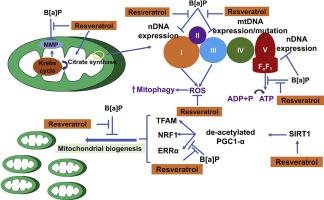当前位置:
X-MOL 学术
›
Free Radical Bio. Med.
›
论文详情
Our official English website, www.x-mol.net, welcomes your
feedback! (Note: you will need to create a separate account there.)
Increased mitochondrial content and function by resveratrol and select flavonoids protects against benzo[a]pyrene-induced bioenergetic dysfunction and ROS generation in a cell model of neoplastic transformation.
Free Radical Biology and Medicine ( IF 7.1 ) Pub Date : 2020-01-20 , DOI: 10.1016/j.freeradbiomed.2020.01.021 Kosar Omidian 1 , Hossein Rafiei 1 , Brian Bandy 1
Free Radical Biology and Medicine ( IF 7.1 ) Pub Date : 2020-01-20 , DOI: 10.1016/j.freeradbiomed.2020.01.021 Kosar Omidian 1 , Hossein Rafiei 1 , Brian Bandy 1
Affiliation

|
Dietary polyphenols act in cancer prevention and may inhibit carcinogenesis. A possible mitochondrial mechanism for carcinogen-induced neoplastic transformation and chemoprevention by polyphenols, however, is largely unexplored. Using the Bhas 42 cell model of carcinogen-induced neoplastic transformation, we investigated benzo[a]pyrene (B[a]P) along with different polyphenols for their effects on mitochondrial content and function, and on mitochondrial and intracellular ROS generation. Bhas 42 cells were either co-treated with 5 μM polyphenol starting 2 h before exposure to 4 μM B[a]P for 24 or 72 h, or pre-treated with polyphenol for 24 h and removed prior to B[a]P exposure. Exposure to B[a]P decreased mitochondrial content (by 46% after 24 h and 30% after 72 h), decreased mitochondrial membrane potential and cellular ATP, and increased generation of mitochondrial superoxide and intracellular ROS. Polyphenol co-treatments protected against the decreased mitochondrial content, with resveratrol being the most effective (increasing the mitochondrial content after 72 h by 75%). Measurements after 24 h of mRNA for mitochondria-related proteins and of SIRT1 enzyme activity suggested an involvement of increased mitochondrial biogenesis in the polyphenol effects. The polyphenol co-treatments also ameliorated B[a]P-induced deficits in mitochondrial function (most strongly resveratrol), and increases in generation of mitochondrial superoxide and intracellular ROS. Notably, 24 h pre-treatments with polyphenols strongly suppressed subsequent B[a]P-induced increases, after 24 and 72 h, in mitochondrial superoxide and intracellular ROS generation, with resveratrol being the most effective. In conclusion, the results support a mechanism for B[a]P carcinogenesis involving impaired mitochondrial function and increased mitochondria-derived ROS, that can be ameliorated by dietary polyphenols. The evidence supports an increase in mitochondrial biogenesis behind the strong chemoprevention by resveratrol, and a mitochondrial antioxidant effect in chemoprevention by quercetin.
中文翻译:

白藜芦醇和选择的类黄酮增加的线粒体含量和功能在肿瘤转化的细胞模型中可以防止苯并[a] py诱导的生物能功能障碍和ROS生成。
饮食中的多酚可预防癌症,并可能抑制癌变。然而,关于致癌物诱导的肿瘤转化和多酚化学预防的线粒体机制可能尚不清楚。使用致癌物诱导的肿瘤转化的Bhas 42细胞模型,我们研究了苯并[a] re(B [a] P)以及不同的多酚对线粒体含量和功能以及线粒体和细胞内ROS生成的影响。Bhas 42细胞在暴露于4μMB [a] P之前2小时开始与5μM多酚共同处理24或72 h,或者在暴露于B [a] P之前用多酚预处理24 h并去除。暴露于B [a] P会降低线粒体含量(24小时后降低46%,72小时后降低30%),线粒体膜电位和细胞ATP降低,并增加线粒体超氧化物和细胞内ROS的产生。多酚共处理可防止线粒体含量减少,其中白藜芦醇最有效(72小时后线粒体含量增加75%)。24小时后,测量线粒体相关蛋白的mRNA和SIRT1酶活性,这表明线粒体生物发生增加与多酚效应有关。多酚共同治疗还改善了B [a] P引起的线粒体功能缺陷(最强烈的白藜芦醇),并增加了线粒体超氧化物和细胞内ROS的产生。值得注意的是,在24和72小时后,用多酚进行的24小时预处理强烈抑制了随后的B [a] P诱导的线粒体超氧化物和细胞内ROS生成的增加,白藜芦醇是最有效的。总之,这些结果支持了B [a] P癌变的机制,该机制涉及线粒体功能受损和线粒体来源的ROS增加,饮食中的多酚可以改善这种机制。证据支持白藜芦醇强力化学预防后线粒体生物发生的增加,以及槲皮素在化学预防中线粒体的抗氧化作用。
更新日期:2020-01-20
中文翻译:

白藜芦醇和选择的类黄酮增加的线粒体含量和功能在肿瘤转化的细胞模型中可以防止苯并[a] py诱导的生物能功能障碍和ROS生成。
饮食中的多酚可预防癌症,并可能抑制癌变。然而,关于致癌物诱导的肿瘤转化和多酚化学预防的线粒体机制可能尚不清楚。使用致癌物诱导的肿瘤转化的Bhas 42细胞模型,我们研究了苯并[a] re(B [a] P)以及不同的多酚对线粒体含量和功能以及线粒体和细胞内ROS生成的影响。Bhas 42细胞在暴露于4μMB [a] P之前2小时开始与5μM多酚共同处理24或72 h,或者在暴露于B [a] P之前用多酚预处理24 h并去除。暴露于B [a] P会降低线粒体含量(24小时后降低46%,72小时后降低30%),线粒体膜电位和细胞ATP降低,并增加线粒体超氧化物和细胞内ROS的产生。多酚共处理可防止线粒体含量减少,其中白藜芦醇最有效(72小时后线粒体含量增加75%)。24小时后,测量线粒体相关蛋白的mRNA和SIRT1酶活性,这表明线粒体生物发生增加与多酚效应有关。多酚共同治疗还改善了B [a] P引起的线粒体功能缺陷(最强烈的白藜芦醇),并增加了线粒体超氧化物和细胞内ROS的产生。值得注意的是,在24和72小时后,用多酚进行的24小时预处理强烈抑制了随后的B [a] P诱导的线粒体超氧化物和细胞内ROS生成的增加,白藜芦醇是最有效的。总之,这些结果支持了B [a] P癌变的机制,该机制涉及线粒体功能受损和线粒体来源的ROS增加,饮食中的多酚可以改善这种机制。证据支持白藜芦醇强力化学预防后线粒体生物发生的增加,以及槲皮素在化学预防中线粒体的抗氧化作用。











































 京公网安备 11010802027423号
京公网安备 11010802027423号